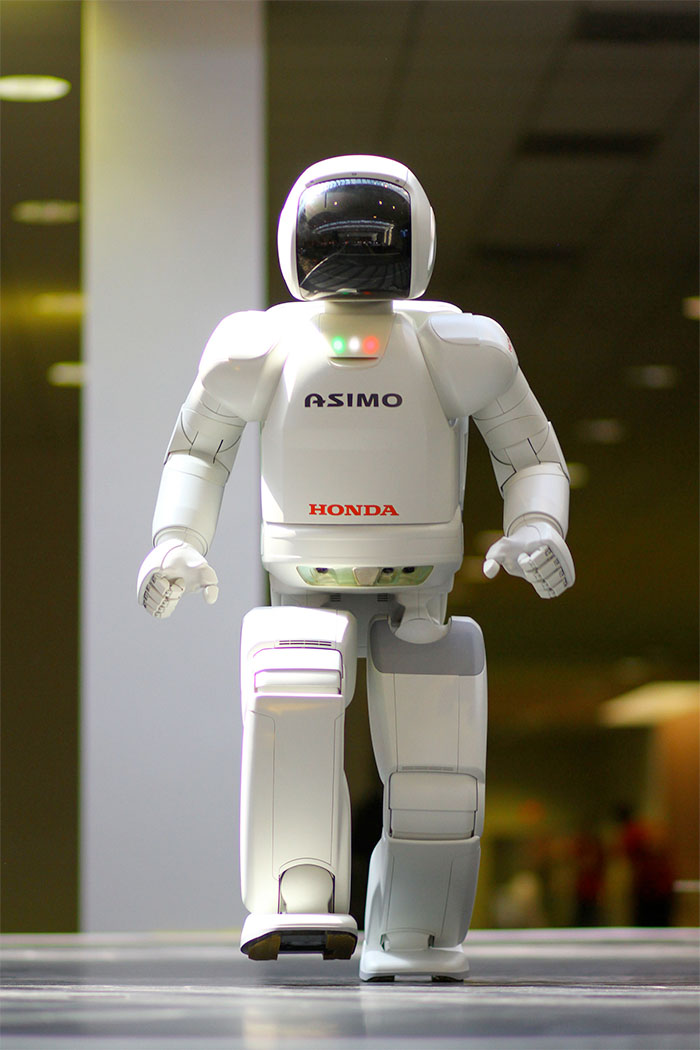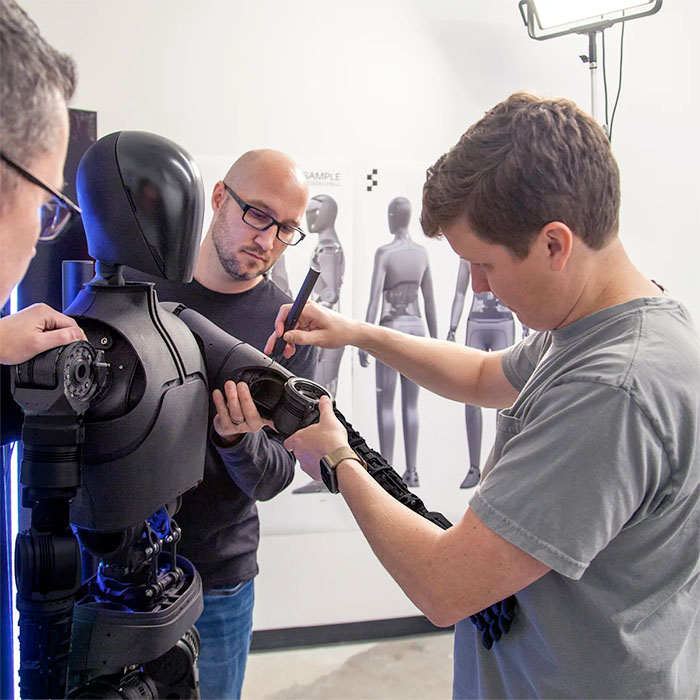|
Listen to this article  |
The age of humanoids is just around the corner. Humanoids are a subset of robotics that feature a bipedal (two legs) design, functional arms and “hands,” a torso and a head. It’s not necessary for these robots to recreate human hands and fingers, but rather to be able to interact with a world designed for humans.
Humanoids have long been relegated to research labs, but the goalposts recently began to shift. Companies are now creating humanoids to perform various real-world tasks. This means humanoids can operate in environments designed for humans and work alongside humans.
In the short term, basic tasks for humanoids will include picking up and moving items either individually or contained within totes or boxes. Advanced functions will eventually include manipulating door knobs, opening and closing doors and drawers, and using tools designed for humans.
We will be hosting a keynote panel at RoboBusiness 2023 to discuss the state of humanoids. Jeff Cardenas, co-founder and CEO of Apptronik, Jonathan Hurst, co-founder and chief robot officer of Agility Robotics, and Geordie Rose, co-founder and CEO of Sanctuary, will explore the technological breakthroughs that are propelling humanoids into the real world. They’ll share their firsthand insights into the challenges and opportunities that lie ahead and discuss the industries poised to be early adopters of these remarkable creations.
Let’s look at some of the humanoids that will soon be released and some of the challenges involved with developing these advanced systems.
Real humanoids won’t be like the movies
While humanoids like the Terminator have long entertained us in movies, creating a functional humanoid for the real world remains a difficult task. Power consumption, power-to-weight optimization, mechanical stiffness, edge computing, component reliability and safety are some of the major engineering constraints of the humanoid design.
For decades, roboticists have worked to perfect humanoids, displaying numerous prototypes and working models. Some researchers have spent their careers perfecting bipedal locomotion or hand design, while others have attempted to program artificial intelligence to give the robots a believable personality that crosses the uncanny valley.
One of the most famous humanoids was Honda’s ASIMO, which was first introduced in 2000. Unlike most modern humanoids, with the exception of Boston Dynamics Atlas, ASIMO was a heavyweight weighing in at 130 kgs (286 lbs).

Honda created ASIMO as a part of the research project Advanced Step in Innovative MObility. ASIMO was inducted into the Robot Hall of Fame in 2004 as the first humanoid able to walk dynamically. | Credit: Honda
Steps in the right direction
Several technical and engineering breakthroughs have occurred since the days of ASIMO, all of which are enabling lighter-weight designs, longer operating times and faster and more capable edge computing. Advances in battery chemistry, from the evolution of electric vehicles, provide the right balance of energy density and lower weight that are necessary to deliver longer runtimes for free-ranging humanoids.
Companies have developed edge computing platforms that can process and fuse sensor data onboard the robot while controlling all of its joints in real time. The processing power of a supercomputer can now be delivered in a small, lightweight form factor.
Artificial intelligence and machine learning have evolved so quickly in the last decade that the upcoming generation of humanoids will be able to learn quickly and respond to changes in their environment. This functionality is necessary if this class of robotics is to achieve its goal of being multi-purpose.
For this next generation of humanoids, developers have a highly capable set of technologies to leverage as they push the boundaries of what’s possible. Let’s take a look at two of the most recognizable humanoids that are currently functional.
Boston Dynamics – Atlas
Boston Dynamics Atlas is likely the most famous (real) humanoid ever produced. Atlas has been featured in a number of YouTube videos and even a Super Bowl commercial, as it performed a number of dance moves and demonstration moves on parkour courses. These videos have garnered millions of views on YouTube.
For all of its amazing abilities, Atlas remains an R&D project, and there are no plans to commercialize Altas in its current form. In fact, Atlas only operates within the confines of Boston Dynamics’ headquarters in Waltham, Mass.
Atlas uses high-pressure hydraulic actuation to move its joints. That would likely have to change before Atlas is suitable for real-world work. Boston Dynamics has leveraged the R&D from Atlas to develop the commercially-available Spot quadruped.
Agility Robotics – Digit
Agility Robotics is currently the only commercially-available humanoid designed for production work and being manufactured in large volumes. The company introduced the fourth-generation Digit earlier in 2023 and is taking orders for warehousing applications.
Digit’s most unique feature is that its knees bend backward. Its legs are derived from the legs of birds and provide a highly efficient kinematic model that is responsive to unexpected inputs while being energy efficient. Agility Robotics currently holds the land speed record for a legged robot in part because of this unique design.
Race is underway
The race is on to design and commercialize the next generation of humanoids. Several companies have raised large funding rounds to support these endeavors.
Here is a wishlist of capabilities for this first generation of humanoids:
-
- Physical proportions of an average human: 155-175 cm (61 in – 69 in); ~70 kg (155 lbs)
- Minimum 4-hour battery life
- Bipedal kinematics
- Two arms with functional end-of-arm tooling or hands
- AI sufficient to learn from human demonstration and communicate in real-time with humans within the environment
Hand and finger design will be a major differentiator for this first generation of humanoid robots. Recreating a mechanical hand with four fingers and an opposable thumb that is analog to the human hand remains a difficult engineering challenge. Most of the robotics companies we highlight in the next section are designing highly-functional hands.
The challenge with hand design is building a hand with the desired flexibility and strength, while still being able to be manufactured at a low cost and be robust enough to survive day-to-day operations in a commercial deployment.
Agility Robotics made a key decision not to implement a high degree of freedom (DOF) hand in Digit, primarily because the robot isn’t deployed into use cases where this is a requirement. Digit has a simple yet robust hand design that enables it to pick up and carry fully loaded totes and boxes within a warehouse. A higher DOF hand may be on the future roadmap for Digit once the market demands it.
The primary requirement for a functional humanoid will be to operate effectively within human-built environments. These robots will be deployed into work environments already occupied by humans, and work side by side with human workers. These operating environments will include manufacturing facilities, warehouses, offices, and hospitals. The goal is not to change any of these environments to fit the robots, but rather for the robots to be adaptive to these environments.
1X – Neo
1X (formerly Halodi Robotics) has already successfully commercialized its first solution Eve, a wheeled, self-balancing humanoid-like robot. Neo is positioned to be a true humanoid with bipedal, legged motion and functional hands.
The company raised an additional $23.5 million in Series A funding in March 2023 that included OpenAI as one of the investors. “1X is at the forefront of augmenting labor through the use of safe, advanced technologies in robotics,” said Brad Lightcap, OpenAI’s COO and manager of the OpenAI Startup Fund. “The OpenAI Startup Fund believes in the approach and impact that 1X can have on the future of work.”
Effectively, 1X is ready to graft the body of Eve to a bipedal leg base for this new generation of robots. The company has already developed autonomous navigation and facility mapping capabilities with Eve. The company has announced that Neo will be released in late 2023.

1X Neo is the first full humanoid bipedal robot to be developed by 1X. | Credit: 1X
Sanctuary.AI – Phoenix
Sanctuary.AI is a Canadian company that has demonstrated five generations of its Phoenix robot. The soon-to-be-released sixth generation will be Sanctuary’s first true humanoid with legs and bipedal motion. Prior generations have evolved the torso, arms, and head of the robot.
With the early versions of Phoenix, Sanctuary developed its Carbon AI software. The company has been prolific over the last year publishing a number of YouTube videos that highlight the evolving capabilities of the early generations of Phoenix.
Here’s a sample of what Phoenix can do today:
Sanctuary.AI is targeting late 2023 for a release of the bipedal edition of Phoenix. The robot will have a height of 170 cm and weigh 70 kg
Apptronik – Apollo
Apptronik has developed and delivered several generations of humanoid exoskeletons for the U.S. Department of Defense. From this work, the company developed Astra, its first-generation humanoid form factor. Similar to the strategy of Sanctuary.AI, Astra was developed as a torso-only demo unit with functional arms and hands. Apptronik developed hand-eye coordination for Astra to pick up and manipulate items.
The Austin, Texas-based company is expected to release a completely new humanoid in late summer 2023 called Apollo. There are no pictures of Apollo available yet, but I got a sneak peek of a prototype during a recent visit to Apptronik’s headquarters. It has developed all of the kinematics for bipedal motion through its exoskeleton projects.
Apollo will be different from other robots on the market because its joints will be actuated by a novel actuator design. Apptronik expects this novel design feature will help reduce costs, reduce complexity, and eliminate failure points while giving joints and limbs the stiffness and actuation they require.
Figure.AI – Figure 01
With the exception of Tesla (and Agility Robotics), Figure AI is one of the best-funded companies in the humanoid race, having raised over $70 million in Series A funding. Our recent podcast conversation with co-founder and CEO Brett Adcock highlighted the progress the company is making toward the first generation of its Figure 01 humanoid.
Founded in 2022, the company has assembled an all-star engineering team with decades of humanoid experience from companies such as Boston Dynamics, Toyota Research Institute, the , Agility Robotics, Google, and Apple.
Adcock is an experienced startup executive who has successfully launched two prior businesses. He sees humanoid development as a challenging problem, but he has a pragmatic approach to solving the big issues and has assembled all of the elements necessary to deliver a viable solution in this market. Figure AI is also teasing a late 2023 launch of its first product.

An image from the recruiting page on the Figure.AI website. | Credit: Figure.AI
Tesla Optimus
In a famous live event, Tesla CEO Elon Musk demonstrated the first walking prototype of its Optimus humanoid. The robot tentatively made its first steps on a stage, and Musk announced this was the first time Optimus walked untethered.
With this demonstration, Tesla also threw its collective hat into the humanoid race. However, as amazing as it might have been to see Optimus walking on stage, the most amazing thing Musk announced was the $20,000 price. At a time in robotics when most (stationary) collaborative robots cost more than that, this milestone seems unrealistic.
However, one advantage for the Tesla Optimus engineering team is that they have an in-house and captive market for Optimus. The team is working with Tesla’s automotive production team to define the use cases for a humanoid. Almost all of the released footage of Optimus shows it operating within a Tesla production facility. Before Optimus is ever released publicly, it will have deployed and iterated on multiple generations within Tesla.
In the months since that first demo, Tesla has continued to release additional videos of Optimus robots performing tasks. Optimus is likely one of the best-funded humanoid development projects, but Tesla has stated it may be 2027 before the product is commercially available.
Xiaomi CyberOne
Xiaomi is one of the largest smartphone manufacturers in Asia, and a public company worth well over $40 billion. The company knows how to design, build, sell, and support consumer electronics. In teasing its CyberOne humanoid, the company generated slick 3D animations of CyberOne, but only one video of real footage of CyberOne onstage with during a launch event.
CyberOne has only been shown with a two-degree of freedom hand/wrist/finger. This is a much simpler design than companies like Tesla, Figure, Sanctuary, and Apptronik are promising. However, this simplified but robust hand design might be more appropriate for a high-end, consumer-style humanoid.
The CyberOne robot is 177 cm and weighs 52 kg, and the list price for the robot has been stated to be $100,000. The company is teasing a 2023 release date for CyberOne, but no more information has been released about the reality of this timeframe.
Fourier Intelligence GR-1
Shanghai-based Fourier Intelligence has produced exoskeletons since 2017. The company recently unveiled its first-generation humanoid called GR-1. Standing 1.65 meters tall and weighing 55 kilograms, GR-1 has 40 degrees of freedom (actuators) all over its body. With a peak torque of 300NM generated by a joint module installed at the hip, the robot can walk at 5 km per hour and carry objects of 50 kg.
The company designed and developed the Fourier Smart Actuator (FSA) all-in-one actuator series as a high-performance, low-cost actuator. The FSA is core to the design of the company’s exoskeletons and now the GR-1.
Fourier is also incorporating AI tools such as ChatGPT into the robot’s interaction model to enable more natural interaction with the humans with whom the GR-1 will collaborate. Fourier Intelligence is investigating opportunities to deploy the robot for disaster relief and response, senior care, and household service.
The year ahead
The next 12 months will be an exciting period with at least five companies promising to release their first-generation humanoids. The key question is just how functional these new robots will be when they are initially released. But difficult challenges still abound:
Containing system cost: There is little doubt these systems will be the most complex, autonomous robots ever developed. But a significant commercialization challenge will be to minimize the bill of materials and develop robust and easily maintainable components. Component costs and the overall system price will be key differentiators for these systems.
Safety will be key: Another hurdle for all of these systems is safety. It’s scary to think about what happens when a 70 kg (155 lb) robot fails and collapses to the ground. If one of these robots loses its footing and either tries to compensate to rebalance or falls over, it could injure nearby humans or damage property. We’ve all seen and laughed at the videos of Boston Dynamics Atlas and Spot being bullied by a handler with a hockey stick, but it’s no joking matter when these robots are working around the general public and non-professional users.
It’s expected that humanoids will eventually be collaborative, working together with humans. The safety features, recovery algorithms, and protocols developed by the various humanoid manufacturers remain important areas of research and development. It will be necessary for all of these vendors to demonstrate that their humanoids are well-behaved and have predictable failure modes before the systems are cleared for deployment.
To help with some of these development challenges, ASTM International recently created a legged robotics subcommittee. The subcommittee will focus on testing and performance standards for legged robots, including humanoids, that operate semi-autonomously or in fully automated modes.
Credit: Source link


Comments are closed.